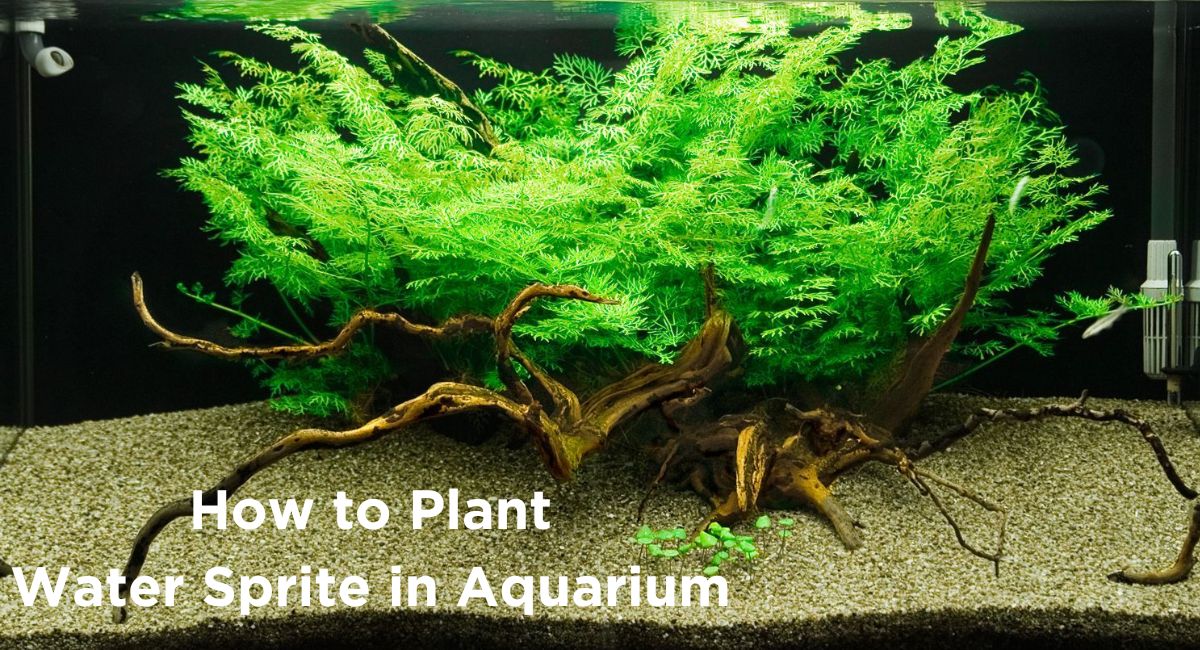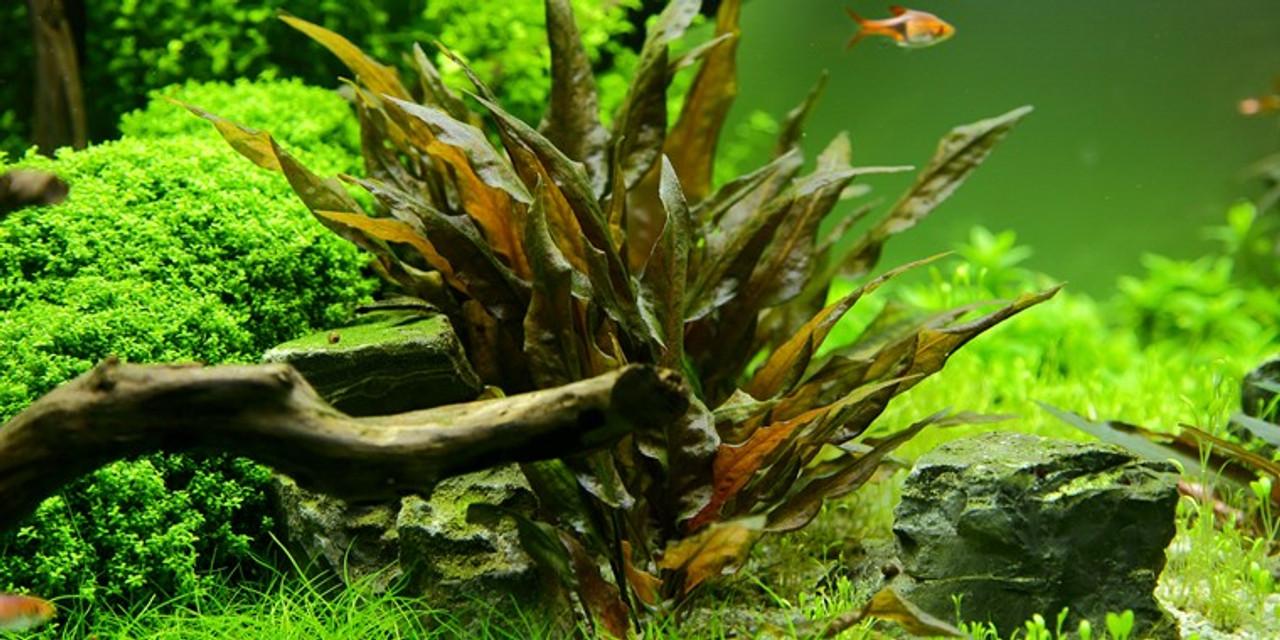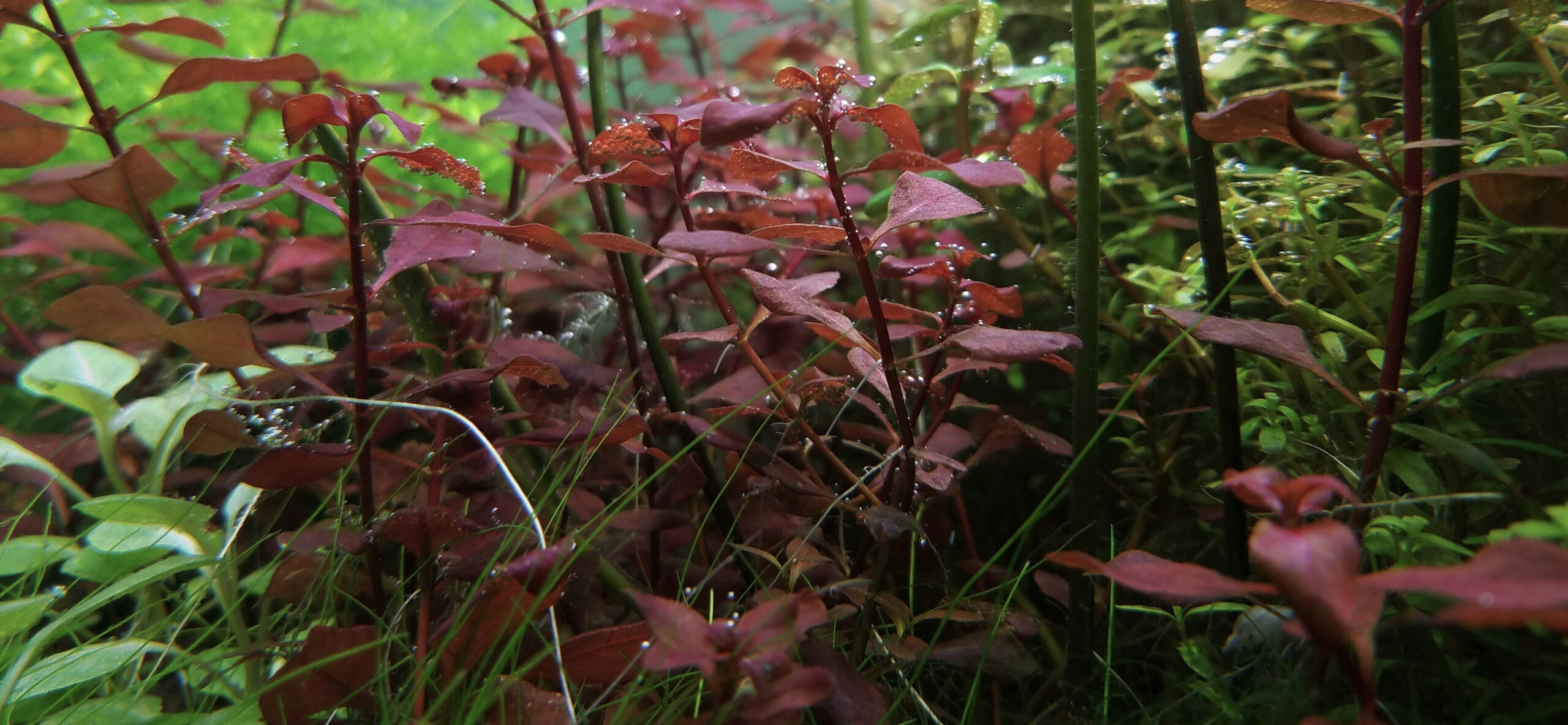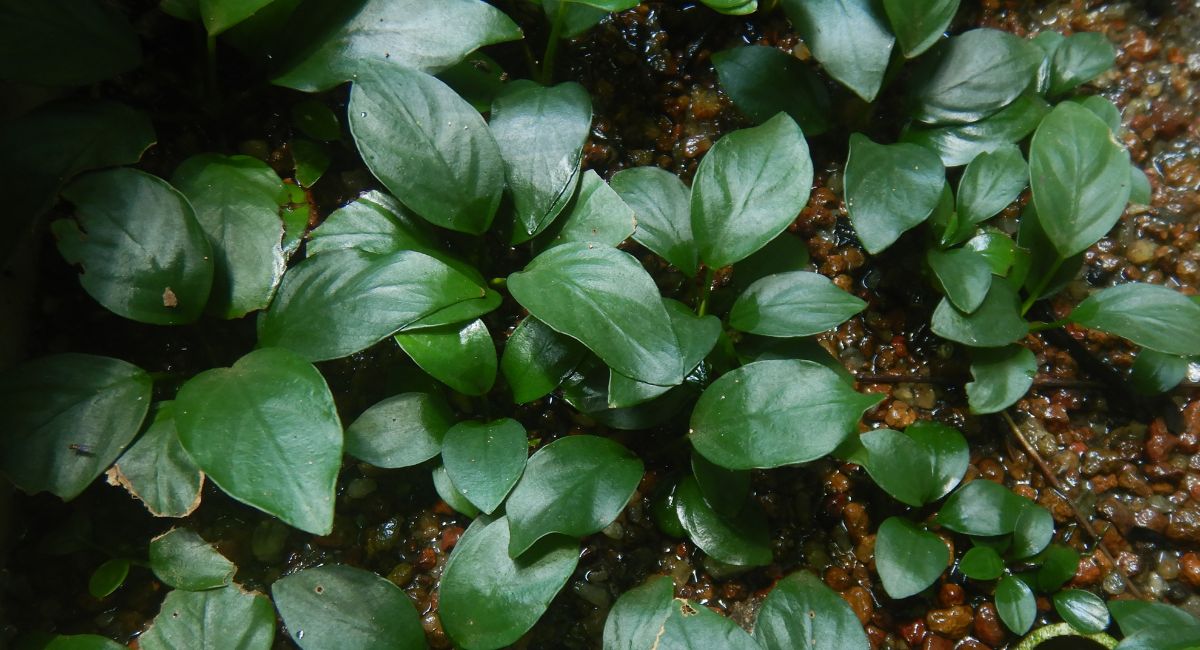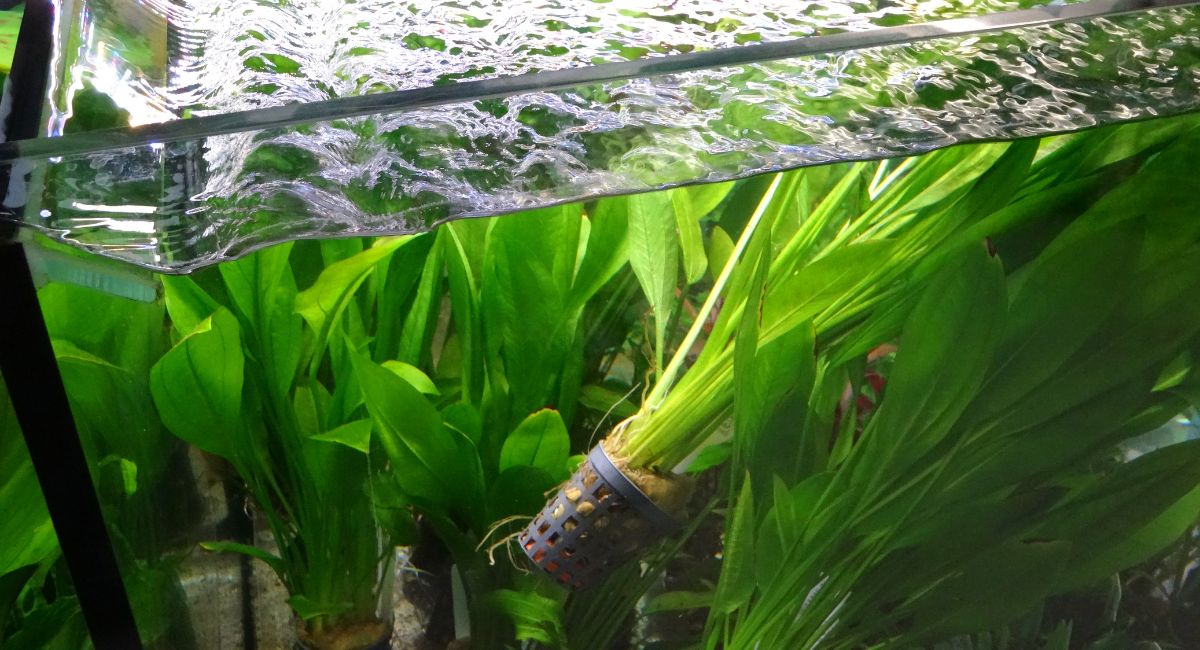Smartplantedaquarium.com participates in affiliate marketing programs. We may earn commissions on purchases made through our affiliate links. This doesn't affect our content or recommendations and we only recommend products we would put in our own tanks.
If you’re a passionate aquarium enthusiast looking to infuse your aquatic haven with an enchanting touch, mastering the art of how to plant Water Sprite can be your gateway to a verdant underwater paradise. With its delicate and graceful appearance, Water Sprite (Ceratopteris thalictroides) has captured the hearts of aquarists worldwide. Whether you’re a seasoned aquarium aficionado seeking to refine your aquatic landscaping skills or a curious beginner taking your first dive into the world of aquatic flora, this comprehensive guide will provide you with step-by-step instructions on planting Water Sprite. Join us as we unravel the secrets to successful cultivation, ensuring that your tank flourishes with the captivating beauty of this iconic aquatic plant.
Contents
- Overview of Water Sprite
- Requirements for Planting Water Sprite in Your Aquarium
- How to Plant Water Sprite?
- Plant Care Timeline for Water Sprite
- Mistakes to Avoid When Planting Water Sprite
- Frequently Asked Questions
- 1. What are the best companion plants for Water Sprite?
- 2. What are the best tank mates for Water Sprite?
- 3. How fast does Water Sprite grow?
- 4. How big does Water Sprite grow?
- 5. What is the growth pattern of Water Sprite?
- 6. Can you propagate Water Sprite?
- 7. Is Water Sprite suitable for beginners?
- 8. Is Water Sprite suitable for a low-tech aquarium?
- Conclusion
Overview of Water Sprite
Water Sprite’s adaptability, easy maintenance, and compatibility with various aquatic species make it a favored choice for both beginners and experienced aquarium enthusiasts. Its fast growth and ability to absorb excess nutrients contribute to a healthy and balanced ecosystem. With its unique floating habit and feathery foliage, this plant adds a touch of natural beauty to any aquarium, creating a serene and captivating underwater landscape.
| Attribute | Description |
|---|---|
| Scientific Name | Ceratopteris thalictroides |
| Common Name | Water Sprite, Indian fern, Water fern, Oriental waterfern, Water hornfern |
| Origin | Native to tropical regions, including Southeast Asia |
| Difficulty Level | Easy |
| Light Requirement | Low to medium |
| Water Conditions | pH: 6.0 – 7.5, Hardness: Soft to moderately hard |
| Best Temperature | 68°F – 82°F (20°C – 28°C) |
| Substrate | Not rooted in substrate; can be anchored or left floating |
| Position in Tank | Background, but can be placed anywhere due to floating habit |
| Growth Rate | Fast |
| Maximum Size | 12 – 24 inches (30 – 60 cm) |
| Compatible Plants | Java Fern, Anubias, Amazon Sword, Hornwort |
| Ideal Tank Mates | Peaceful community fish, shrimp, snails |
| Feeding and Nutrients | Grows well without additional feeding; absorbs nutrients from the water |
| Maintenance and Care | Low maintenance; trim dead or yellowing leaves regularly |
| Propagation | Easily propagates through adventitious plantlets and spores |
Requirements for Planting Water Sprite in Your Aquarium
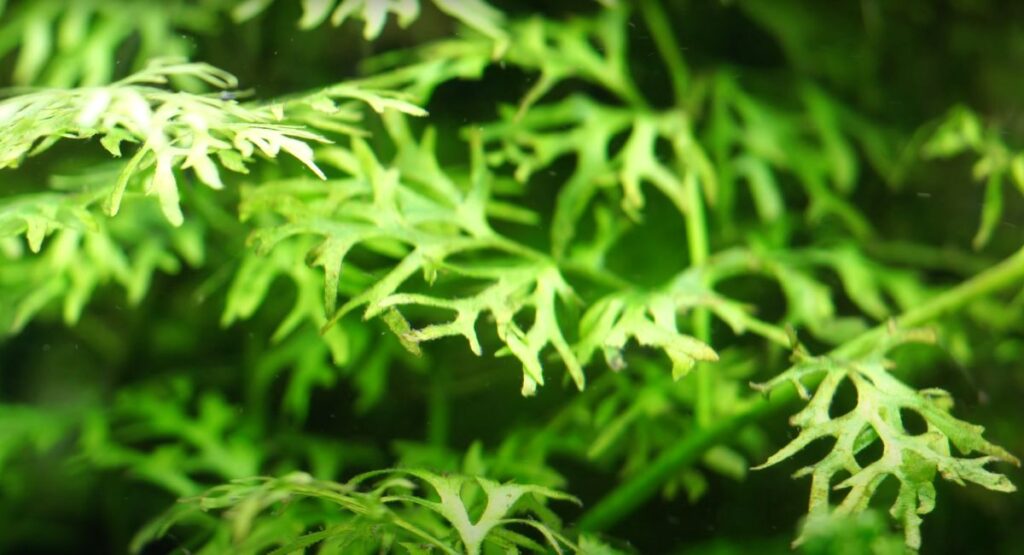
Before adding the enchanting Water Sprite to your aquarium, it’s crucial to understand the specific requirements that will enable it to thrive. In this section, we will explore the key factors for successful cultivation: light, water conditions, and substrate.
Light
Water Fern is considered a low to medium light-demanding plant. It thrives best under moderate illumination, but it can also adapt to lower light conditions. Placing the aquarium near a window or using low-intensity LED lights is usually sufficient to meet its light needs. However, it’s essential to strike a balance, as too much light can lead to excessive algae growth, especially in small aquariums.
Providing 8 to 10 hours of light per day is generally recommended for Water Sprite. Implementing a timer for your aquarium lights can help maintain a consistent light cycle, simulating natural daylight conditions and promoting the plant’s health and growth.
Water Conditions
Water Sprite thrives in a tropical environment, appreciating temperatures ranging from 68°F to 82°F (20°C to 28°C). Maintaining a stable water temperature within this range will ensure optimal growth.
In terms of water chemistry, the ideal pH level for Indian Fern falls between 6.0 and 7.5, indicating a slightly acidic to neutral environment. Additionally, it prefers water with soft to moderately hard levels of water hardness, which can be achieved through the appropriate use of water conditioners.
Water Sprite can tolerate a wide range of water conditions, making it a hardy and adaptable plant. However, avoid sudden fluctuations in water parameters, as stability is vital for its well-being.
Regular water changes are essential to maintain water quality and provide a healthy environment for both the plant and the aquarium’s inhabitants.
Substrate
One of the fascinating aspects of Water Fern is that it does not require traditional substrate planting. The plant can either be anchored to the substrate or left to float freely in the water. If you choose to anchor it, you can use a fine substrate like sand or small gravel. Alternatively, you can secure it to a piece of driftwood or rock, allowing it to attach and grow.
Floating Water Sprite is a sight to behold, adding a touch of elegance to the water’s surface while providing shade for fish below. On the other hand, rooting Water Sprite in the substrate can create a lush background or midground carpet, enhancing the aquarium’s overall aesthetic.
How to Plant Water Sprite?
Adding the captivating Water Sprite to your aquarium can elevate its beauty and contribute to a thriving aquatic environment. In this step-by-step guide, we will walk you through the process of planting this aquatic plant, ensuring a successful and enjoyable experience for both you and your aquatic companions.
Step 1: Preparing Your Aquarium
Before introducing Water Sprite to your aquarium, take the following steps to ensure a suitable environment for the plant:
- Clean the Tank: Thoroughly clean the aquarium to remove any debris or impurities that could hinder the plant’s growth. Scrub the glass, rinse the substrate, and clean any decorations.
- Water Conditioning: Treat tap water with a water conditioner to remove harmful chemicals, such as chlorine and chloramines, that may be present in the water.
- Choose the Right Spot: Select a suitable location in your aquarium for planting Water Sprite. Since it can thrive in various positions, consider your aquascape design and how the plant will complement the overall look.
Step 2: Preparing Water Sprite
Before planting, follow these steps to prepare the Water Sprite:
- Trimming: Inspect the Water Fern for any damaged or yellowing leaves. Trim these off with clean, sharp scissors to encourage healthy growth.
- Soaking (Optional): If your Indian Fern arrives in an emersed form or has been stored dry, consider soaking it in water for a few hours before planting. This will rehydrate the plant and improve its chances of acclimating to the submerged environment.
Step 3: Planting Water Sprite
Now it’s time to introduce Water Sprite into your aquarium. Follow these steps for a smooth planting process:
- Anchoring or Floating: Decide whether you want to anchor the Water hornfern in the substrate or leave it to float. If anchoring, gently insert the roots into the substrate, making sure not to bury the crown. For floating, simply release the plant onto the water’s surface.
- Spacing: Provide adequate space between each Water Sprite plant to allow room for growth and prevent overcrowding. Aim for at least a few inches between individual plants to ensure they have enough space to flourish.
- Depth: If anchoring the Water Sprite, ensure the roots are partially buried in the substrate, while the crown (where the leaves meet the roots) remains above the substrate.
Step 4: Post-Planting Care
After planting, attend to the following care guidelines to help Water Sprite settle into its new home:
- Lighting and Duration: Ensure the aquarium receives the right amount of light, as mentioned in the earlier section. Maintain a consistent light cycle of 8 to 10 hours per day.
- Water Conditions: Monitor and maintain stable water parameters within the recommended range of temperature, pH, and hardness to promote healthy growth.
- Avoid Disturbance: Limit disturbances to the newly planted Water Sprite for a few days, allowing it to acclimate and root securely.
- Regular Maintenance: Perform routine aquarium maintenance, including water changes and debris removal, to keep the tank environment pristine and conducive to plant growth.
Plant Care Timeline for Water Sprite
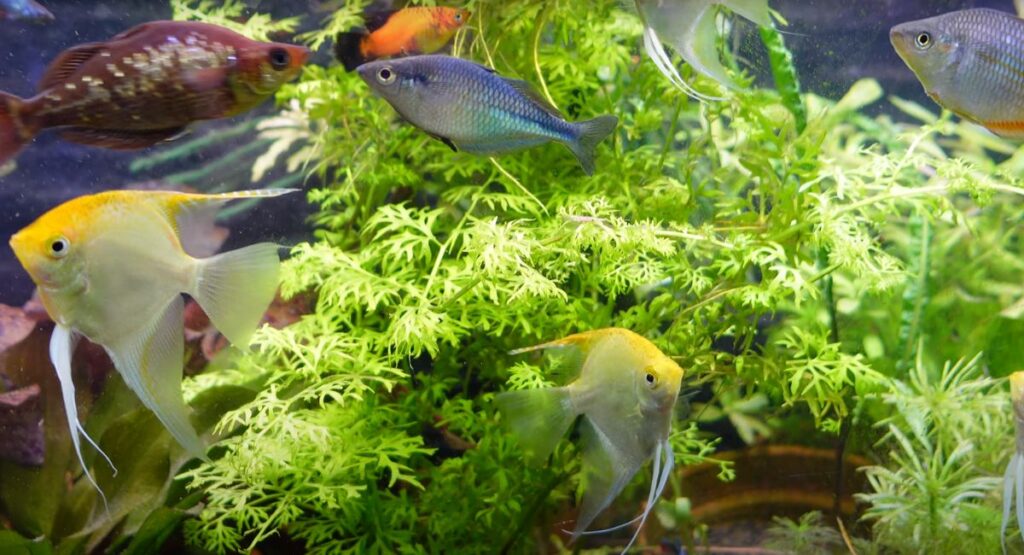
Taking care of your Water Sprite is essential to ensure its long-term health and vibrant appearance. Below is a comprehensive timeline of care tasks that will help you keep your Water Sprite thriving in your aquarium:
Weekly Care Tasks
- Trimming: Check for any yellowing or damaged leaves on your Water Sprite. Trim them off with clean, sharp scissors to encourage new growth and maintain a tidy appearance.
- Inspect for Pests: Regularly inspect the plant and surrounding areas for any signs of pests, such as snails or algae. Address any pest issues promptly to prevent infestations.
Bi-Weekly Care Tasks
- Fertilization (If Needed): If your Water Sprite is showing signs of slow growth or pale leaves, consider adding a liquid aquarium plant fertilizer. Follow the manufacturer’s instructions for application, being careful not to over-fertilize.
- Prune Overgrowth: If your Water Sprite is growing too densely and obstructing light for other plants or fish, thin out the excess growth. This will help maintain a balanced ecosystem in your aquarium.
Monthly Care Tasks
- Check Water Parameters: Regularly test the water quality in your aquarium, including pH, ammonia, nitrite, and nitrate levels. Ensure that water parameters remain stable within the recommended range.
- Partial Water Change: Perform a partial water change of about 25% to 30% of the aquarium water. This helps remove accumulated toxins and replenishes essential minerals for plant growth.
Quarterly Care Tasks
- Prune and Replant: Every few months, assess the overall growth of your Water Sprite. If the plant has become too dense or crowded, remove excess portions and replant them to create new areas of growth.
- Check for Signs of Disease: Inspect your Water Sprite and other tank inhabitants for any signs of diseases, such as wilting, discoloration, or unusual behavior. If you notice any issues, take appropriate action, such as quarantine or treatment, to prevent the spread of disease.
Yearly Care Tasks
- Transplanting (If Necessary): If your Water Sprite has outgrown its current location or needs rejuvenation, consider transplanting it to a new spot in the aquarium or providing fresh substrate for rooting.
- Evaluate Compatibility: Reevaluate the compatibility of your Water Sprite with other aquatic plants and tank mates. Make adjustments to the aquarium layout as needed to create a harmonious environment.
Mistakes to Avoid When Planting Water Sprite
Planting Water Sprite in your aquarium can be a rewarding experience, but like any endeavor, it comes with its challenges. To ensure the best possible outcome for your aquatic wonderland, here are some common mistakes to avoid when planting Water Sprite:
Overcrowding: While Water hornfern is a beautiful and versatile plant, avoid overcrowding your aquarium with it. Planting too many specimens can lead to competition for resources and inhibit their growth.
Insufficient Light: Although Water Sprite can tolerate low to medium light, inadequate lighting can impede its growth and cause it to lose its vibrant color. Ensure the aquarium receives enough light for optimal development.
Inconsistent Lighting Duration: Inconsistent lighting durations can disrupt the plant’s natural cycle, affecting its health and growth. Use a timer to maintain a consistent light cycle of 8 to 10 hours per day.
Neglecting Water Quality: This plant thrives in stable water conditions. Neglecting water quality can lead to nutrient deficiencies or the onset of algae growth. Regularly test and maintain proper water parameters.
Over-Fertilization: While occasional fertilization may be beneficial, over-fertilizing can cause nutrient imbalances and harm the plant. Follow the recommended dosage and frequency on the fertilizer package.
Planting Too Deep: If you choose to anchor Water hornfern in the substrate, avoid planting it too deep. Planting too deeply can lead to rot and hinder the plant’s growth.
Neglecting Pruning: Regular pruning is essential to maintain a healthy Ceratopteris thalictroides. Neglecting to trim yellowing or damaged leaves can affect the overall appearance and health of the plant.
Ignoring Pest Infestations: Pests can quickly damage Water hornfern and other aquarium inhabitants. Address any pest infestations promptly to prevent them from spreading and causing further harm.
Sudden Changes in Water Parameters: Ceratopteris thalictroides prefers stable conditions. Rapid changes in water temperature or chemistry can shock and stress the plant. Gradually acclimate it to new conditions if needed.
Ignoring Compatibility: Not all aquarium plants and fish species are compatible with Water Sprite. Research and consider the needs and behaviors of other tank inhabitants to ensure harmony in the ecosystem.
Frequently Asked Questions
1. What are the best companion plants for Water Sprite?
Water Sprite is a versatile plant that can coexist harmoniously with various other aquatic plants. Some excellent companion plants for Water Sprite include Java Fern, Anubias, Amazon Sword, and Hornwort. These plants share similar requirements and complement each other, creating a lush and captivating underwater landscape.
2. What are the best tank mates for Water Sprite?
Water Sprite is known for its peaceful nature, making it an ideal companion for a wide range of aquarium inhabitants. Some suitable tank mates include community fish like Tetras, Guppies, and Corydoras catfish. Shrimp, such as Cherry Shrimp or Amano Shrimp, can also coexist well with Water Sprite. Avoid aggressive or large species that may damage the delicate foliage.
3. How fast does Water Sprite grow?
Water Sprite is a fast-growing plant, and under ideal conditions, it can grow several inches per week. Its rapid growth rate makes it an excellent choice for filling in empty spaces in your aquarium and providing quick coverage.
4. How big does Water Sprite grow?
In an aquarium setting, Water Sprite can reach a height of 12 to 24 inches (30 to 60 cm). The plant’s feathery leaves and fine fronds give it a delicate appearance that adds elegance to any aquarium layout.
5. What is the growth pattern of Water Sprite?
Water Sprite has a floating growth habit, which means it typically does not anchor its roots in the substrate. Instead, it gracefully floats on the water’s surface, creating a beautiful canopy and providing shade for the aquatic life below. It can also be anchored to the substrate if desired.
6. Can you propagate Water Sprite?
Yes, Water Sprite is easy to propagate, making it a popular choice for aquarium enthusiasts. It reproduces through spores and forms adventitious plantlets along the leaf margins. These tiny plantlets can be carefully separated and replanted to propagate the plant and expand your Water Sprite population.
7. Is Water Sprite suitable for beginners?
Yes, Water Sprite is an excellent choice for beginners due to its ease of care and adaptability to various water conditions. Its resilience and fast growth make it forgiving for novice aquarium keepers.
8. Is Water Sprite suitable for a low-tech aquarium?
Yes, Water Sprite is well-suited for low-tech aquarium setups. It can thrive in low to medium light conditions and does not require additional CO2 injection. It can absorb nutrients from the water column, making it an ideal choice for low-tech or natural-style aquariums.
Conclusion
Planting and caring for water sprite can be a rewarding and enriching experience for any aquatic hobbyist or pond owner. By following the guidelines outlined in this article, one can successfully introduce this beautiful and versatile plant into their aquatic ecosystem.
Remember to provide adequate lighting, nutrient-rich water, and appropriate water conditions to encourage healthy growth. Regular pruning and maintenance will help to prevent overgrowth and ensure the Ceratopteris thalictroides thrives while maintaining a balanced ecosystem.
Whether in aquariums, ponds, or water gardens, the addition of water sprite can significantly enhance the aesthetics and ecological balance of the environment. As with any plant, patience and observation are key as you adapt your care routine to the specific needs of your Water hornfern.
With proper attention and dedication, this vibrant and adaptable aquatic plant will bring beauty and serenity to your aquatic world for years to come.
Also read How to Plant Amazon Frogbit, How to Plant Java Fern, How to Plant Amazon Sword Plant, and How to Plant Anubias Nana.
